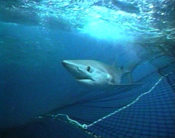Concerned Scientific Community Calls for European Conservation of Sharks and Rays

European marine scientists at a weekend shark and ray conference signed a Statement of Concern calling for improved European shark policies, bringing the total number of signatories over the 100 mark. The Statement was publicised by the Shark Alliance at the annual meeting of the European Elasmobranch Association (EEA), the leading regional, scientific society dedicated to the study of sharks, skates and rays (collectively known as “elasmobranchs”), hosted by the France-based Association Pour l'Etude et la Conservation des Sélaciens (APECS). The Statement calls on European Union (EU) Ministers and fisheries managers to heed scientific advice for fishing limits and develop an EU shark plan.
“The growing number of scientists signing this Statement reflects substantial and increasing concern about the depletion of European sharks and rays,” said Sonja Fordham, Shark Alliance Policy Director, who delivered the keynote address at the conference. “These experts in marine science have a keen understanding of the seriousness of the situation and the need for immediate action. We are hopeful that EU fisheries Ministers and managers will give special consideration to this compelling perspective and act accordingly to safeguard Europe's exceptionally imperilled sharks and rays.”
Through the Statement, the experts express their deep concern over the failure of EU fisheries managers to heed scientific advice for several threatened shark species in European waters – notably spiny dogfish, porbeagle, and deepwater sharks - and the lack of restriction on catch of many other vulnerable shark and ray species in the region. The Statement calls for immediate, science-based limits on shark catches and prompt development of an EU plan to improve the assessment and conservation status of shark populations.
Sharks and rays generally grow slowly, mature late and produce few young, leaving their populations especially susceptible to overfishing and slow to recover once depleted. Most European shark and ray populations have been overfished, some seriously so. The IUCN has deemed one third of European elasmobranchs as threatened with extinction. Several populations will already require many decades to rebuild, and yet they continue to be subject to excessive fishing pressure.
The Statement has been signed by scientists from countries all over the EU and around the world, including France, Italy, Portugal, the UK, Sweden, Germany and Greece. The statement was also endorsed by the Italian Society for Marine Biology, a group of 830 ocean researchers from Italy, France, Spain, Malta and Monaco.
Next week, the European Commission is expected to announce its proposals for catch limits on porbeagle and spiny dogfish sharks, both considered Critically Endangered by the IUCN. For both species, scientists advising the Commission have recommended an end to targeted fishing and minimisation of incidental catch. Final decisions on fishing catch limits will be taken by EU Fisheries Ministers during the December 17-20 meeting.






